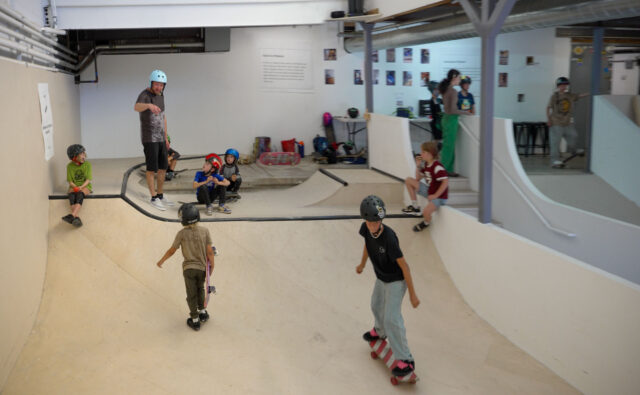Helping Kids Thrive in the Transition from Elementary to Middle School
The transition from elementary to middle school is an exciting time of growth and independence, but it can also bring feelings of anxiety and sadness as kids move from a familiar environment to a new one. It's completely normal to feel nervous about starting middle school. The shift often means balancing multiple teachers, assignments, activities, new friends, and increased responsibilities—it's a lot to handle! The good news is that support from a trusted adult can help make this transition easier and boost a student’s confidence as they adjust.
March 31, 2025

Below are some tips to help children prepare for this change:
1. Find Opportunities to Feel in Control
Encourage your child to take control where possible and help them create a plan. For example, the plan might look like this:
- June, July, and August: Visit the campus twice to increase familiarity. Review and read any letters or emails from the school.
- August: Check for supply lists from the teachers and help your child prepare their backpack with the necessary supplies.
“The single most powerful force for mitigating stress is a feeling of control.” - Dr. Lisa Damour, Untangled
2. Create a Predictable Routine
Predictability can help reduce uncertainty. Create a general weekly schedule that includes bedtime, wake-up time, after-school activities, and designated family time. Prioritizing sleep is especially important—middle schoolers need around 9–11 hours of sleep each night to support focus, mood, and overall well-being. Try to establish consistent sleep and wake times, even on weekends, to help their internal clock adjust.
Practice your routine for a couple of weeks before the school year starts. Establishing simple habits—like setting a regular time for homework, packing backpacks the night before, and taking time to unwind after school—can create a sense of stability and calm during times of transition.
“Sleep is a nonnegotiable biological necessity. It is your life-support system.” - Dr. Matthew Walker, Sleep Scientist
3. Encourage Social Courage
Making new friends (or navigating changing friendships) is a big part of adolescence and middle school. Some kids are naturally outgoing, while others may feel uneasy in social situations and might need support in learning how to engage. Remind kids that it's okay to start small—simple actions like smiling, saying hi, or joining a club can help them connect with peers. Some kids may find that they need some additional time to observe, process, and understand the new social environment. Normalize this for your child and give them this time to allow for the possibility of new, healthy friendships and social circles to form.
“The adolescent brain is wired for social engagement,” Dr. Dan Siegel, Whole-Brain Child
4. Emphasize Growth Mindset
Middle school brings more responsibility, as well as more opportunities to make mistakes. At this age, your child may have a fixed mindset and be their own toughest critic when they make a mistake. Encourage them to adopt a growth mindset, where mistakes are seen as part of the learning process. Celebrate their efforts and the progress they make toward their goals!
- Growth Mindset is the belief that your abilities can be developed through effort, learning, and perseverance.
- Fixed Mindset is the belief that your abilities, intelligence, and talents are fixed traits that cannot be changed. This mindset can sometimes lead to avoiding challenges and giving up easily when things get tough.
“Our job is not to protect our kids from struggle but to help them feel safe enough to try, fail, and try again.” - Dr. Tina Payne Bryson, The Power of Showing Up
“The Science of Character”. The Science of Character - Recommended Short Film
5. Connect with School Support Systems
Having a trusted adult, knowing what support is available at school, and connecting with older peers can help ease anxiety. Help your child identify a trusted adult at school and learn about the available support systems. A trusted adult could be a teacher, the school counselor, or even a friendly office staff member. Hood River Schools also hosts a “preview day” specifically for incoming 6th graders. This day allows students to explore the campus in a quieter environment, review and practice their schedule, and receive support as needed. Older peers will be there to greet them, answer questions, and provide assistance. These peer connections can help your child feel seen and supported. Don’t forget to remind them about the "preview day" over the summer!
6. Teach Emotional Regulation & Breathing Techniques
Middle school can be a rollercoaster. Teaching kids how to pause and breathe through overwhelming moments can make all the difference. Encourage simple tools like deep breathing, journaling, or movement (a quick walk or stretch can help reset the brain to increased focus) to encourage familiarity with the benefits of these coping skills. Join your children in these exercises to help them grow their skills!
Breathing Techniques:
- Box Breathing: Inhale for 4 seconds, hold for 4 seconds, exhale for 4 seconds, hold for 4 seconds. Repeat.
- 5-7-8 Breathing: Inhale for 5 seconds, hold for 7, exhale for 8. This calms the nervous system.
- Belly Breathing: Place a hand on the belly and take slow, deep breaths, making sure the belly rises with each inhale.
Other Calm Body Strategies:
- Progressive Muscle Squeeze – Encourage your child to squeeze their fists, shoulders, or legs tightly for five seconds and then release. This helps their body physically release built-up tension and can make them feel more relaxed.
- Sensory Grounding with Objects – Encourage your child to keep a small, textured object (like a stress ball, smooth rock, or fidget toy) in their pocket. They can focus on the texture, temperature, and shape to help shift attention away from anxious thoughts.
- Shake It Out – Encourage your child to discreetly shake their hands, legs, or even wiggle their fingers under their desk. Shaking helps release excess energy and tension stored in the body, making them feel more at ease.
7. Emotion Coach Big Feelings
Adolescents may resist advice and minimize their worries. This is a normal part of their brain development.
Validate your child’s emotions and use “I messages” to help them process their feelings. This can look like “I see that you are nervous. It’s okay to feel nervous.” A good way to remember this is “Name it to tame it.” Encourage your child to name their feeling as a way to tame their emotion (Dr. Dan Siegel).
“When children feel safe and connected, they can handle challenges better.” - Dr. Becky Kennedy, Clinical Psychologist and Parenting Expert
8. Managing Anxiety & Catastrophizing
At this age, your child may have some big worries about middle school such as who they will sit with at lunch, how they do on a test, and if they will make a social mistake.
A trusted adult can help by intentionally listening and staying curious as you:
- Give a Reality Check: Ask, “Has something like this happened before? How did it turn out?”
- Worst/ Best/ Likely Outcome: Encourage your child to think through the worst, best, and most realistic outcomes.
- Validate: “I hear that you’re worried about getting lost. That makes sense—it’s a new place.”
- Reframe: Child says, “No one will like me.” Adult responds, “It sounds like you are unsure of how to make friends.”
9. Regulate Yourself as a Parent
Children are very in tune with their parents’ emotional states and often mirror their feelings and actions. It’s essential for parents to practice and model self-regulation, calmness, and healthy habits during this time. If sharing about your own middle school experiences be mindful not to overshare, as this may unintentionally discourage your child from opening up.
Here are some strategies to help you manage your own anxiety:
- Take a few deep breaths or count to 20 before responding to your child.
- Acknowledge and validate your own feelings, saying them aloud: “I feel nervous about this change, and that’s okay.”
- Model confidence and offer frequent reassurance: “I know this is a big transition, and I believe in you. We’ll figure things out together” and “You can do hard things.
“The best thing we can do for our kids’ emotional regulation is to regulate ourselves first.” - Dr. Becky Kennedy
10. Keep the Lines of Communication Open
- Daily Reflections: Your middle schooler may not tell you about their day when asked. Stay curious and look for casual connection points—car rides, bedtime chats, or during shared activities. Ask open-ended questions instead of closed-ended questions (avoid yes or no answers). Be patient as sharing and reflecting is a skill that takes practice and vulnerability.
- Home- School Communication: Middle schoolers are encouraged to take more and more responsibility for their learning. This often includes being increasingly in charge of receiving and sharing information between school and home. While you want to support your child’s skill in more independently navigating their education, you also don’t assume that no news is good news. Check in regularly, attend meetings when possible, and keep the lines of communication open with their teachers and counselors. It is okay and normal to email any of your child’s teachers with questions. Your involvement shows your child that you’re invested in their well-being and helps create a strong support system between home and school.
More tips to come!
Be on the lookout for a fillable worksheet in early August to help you as you support your child in navigating their transition to middle school!
Final Thoughts
This transition is significant, but so is your child’s ability to adapt. With support, patience, and a bit of humor along the way, they won’t just survive—they’ll thrive. Remember, you don’t need to have all the answers. Simply being a steady, loving presence in their life is very powerful and impactful.





